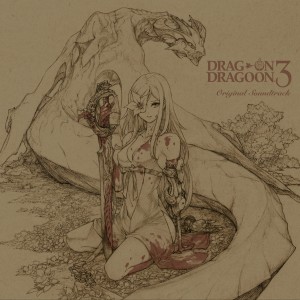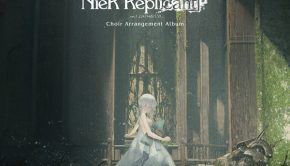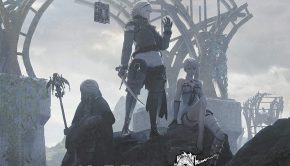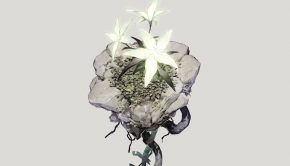Drakengard 3 Original Soundtrack
 |
Album Title: Drakengard 3 Original Soundtrack (Drag-on Dragoon 3 Original Soundtrack) |
| Record Label: Square Enix |
|
| Catalog No.: SQEX-10414/5 |
|
| Release Date: January 22, 2014 |
|
| Purchase: Buy at CDJapan |
Overview
The Drakengard series (or Drag-on Dragoon as titled in Japanese) has been known for its interesting stories and music. It received a spin-off title, Nier, with a soundtrack helmed by the MONACA team that was listed by many as their pick for Soundtrack of the Year. The music team returned for the latest entry in the series Drakengard 3, aiming to create a soundtrack that fit in the series universe while offering a different experience from previous scores in the series. Interestingly, the titles of songs (both in Japanese and in English) are for the most part not real words, but are new made-up compound words. Like with Nier, a lot of the lyrics are nonsensical, present for tones and textures but not for conveying any literal meaning. Although the direction is considerably different than that of Nier and of the previous instalments, it is still has the dark and foreboding feel associated with the series, injected with a healthy dose of insanity.
Body
The game’s story revolves around six sisters who possess strong magical powers employed through song. Each of the five antagonist sisters has their own theme: “Exvulsion” for Five, “Prevolt” for Four, “Corroscience” for Three, “Blissade” for Two, and “Companthem” for One. The lyrics for these themes are fragmented Japanese sentences that give hints of what goes on behind their personae. Each theme has three incarnations, the first of which is the “Battlefield” version which appears during the regular stages of the game. Stylistically the battlefield versions are all the same: swirling strings and heavy brass arrangement with fast-paced percussion, with one of the sections playing the melody of the theme. In the second half of each song, vocalist Nami Nakagawa (the Nier female chorus) comes in to sing the melody which is only heard in the game when the player activates Intoner mode. The songs are pressing with an atmosphere of chaos, but are all a bit too similar and repetitive to make an individualist impact despite their strong melodies. An improvement would have been to change the accompaniment when the vocals are introduced, rather than having them double up on the melody.
The sisters’ themes shine more on their boss battle versions, which make up most of the second disc where there are two of boss versions for each theme. Admittedly, they are again all stylistically similar, trading the orchestra for a gritty electronic-rock approach. However, there’s enough variety here to keep things interesting from track to track, and the distorted J-Pop vocals from YoHRa are well-suited to this style. The themes might have benefitted from a bridges, instrumental solos, more dynamic changes, or even the inclusion of the blur of vocal samples that occurs while Intoner mode is activated during boss battles to better justify the track length, but these versions are still enjoyable additions that also carry enough madness and intensity to fit alongside the orchestral offerings of the soundtrack and series.
Outside of the sisters’ themes, the soundtrack offers a number of other songs. Regrettably, a number of these also play during regular stages and are also “Battlefield” tracks. These follow the same structure and instrumentation as the sisters’ “Battlefield” tracks, and come off feeling like filler. The only tracks that break out from the mould here are the tribal ”Pulchregeist” with its marimba and the dreamy “Wilderblades” with its distorted chimes and bells. More interesting are the more atmospheric tracks that change up the sound. “Nethernox” is a simple but haunting piece that makes great use of distortion and sparse tones. “Voidscape” interestingly uses the lyrics of “Prevolt” for a sombre chant, and “Better End” uses sounds of children playing and chirping birds to set the stage for the album. Emi Evans (who also sang on Nier) lends her ethereal voice to the two gems of tracks, “Descendeus” and “Aethervox”, with soft and beautiful instrumentation that altogether would not have felt out of place in Nier (which is a great thing).
The main themes presented in the soundtrack are the naturally strongest. “Exhausted 3” is a rearrangement of the original track from the first Drag-on Dragoon game, retaining heavy use of repetitive, fragmented sampling. The vocal is given a bit more emphasis here, and more distortion is used to match the styling for this soundtrack. It won’t take the spotlight from the original, but its as brilliant and dark as it ever was. The new theme, “Kuroi Uta” has two versions with slightly different arrangements, one with rising J-Pop artist Eir Aoi and one with Emi Evans. Though each version goes through the same progression from a soft opening to explosive finale, both vocalists offer distinct takes on this dramatic piece which wonderfully encapsulates the beautiful tragedy that is Drag-on Dragoon 3. Emi Evans also sings in the pinnacle of the score, “The Last Song”, which is a dynamic medley of the five sisters’ themes and “Kuroi Uta” (acting as Zero’s theme). It has great instrumentation throughout, and offers yet another different take on each of the themes. It isn’t epic like the boss battle versions, but it’s just as powerful and feels more exotic and moving. The ending theme of the game is “This Silence is Mine” sung by J-Pop artist Chihiro Onitsuka, which she personally penned for the game. Known outside of gaming for her songwriting abilities, inspired lyrics, and raw performances, Onitsuka is a perfect match for the series. Here she brings her best, delivering an emotional track with a powerful buildup to a dizzying climax. MONACA assists in crafting a haunting and harsh arrangement to bridge her tone to the mood of the game, making it a brilliant ending to a solid soundtrack.
Summary
In Drakengard 3, MONACA succeeds in creating a soundtrack that is different from other entries in the series, while still matching the feel of the others with a dark atmosphere of madness. The only letdown of the album is the “Battlefield” category of tracks, which for the most part are repetitive. The five antagonist sisters’ themes are great as boss battles tracks, if a bit similar as well. There are some real gems among the standalone pieces, and the central and end game themes are all powerful and moving. Although it would have benefitted from more variety, the collection of tracks is strong in quality and is a great entry to both the Drakengard universe as well as MONACA’s portfolio. Hopefully the team will have an opportunity to expand further on the score in an arrangement album, or at least in a few bonus tracks for the inevitable DLC music album.
Do you agree with the review and score? Let us know in the comments below!
4
Posted on May 21, 2014 by Christopher Huynh. Last modified on October 5, 2014.














